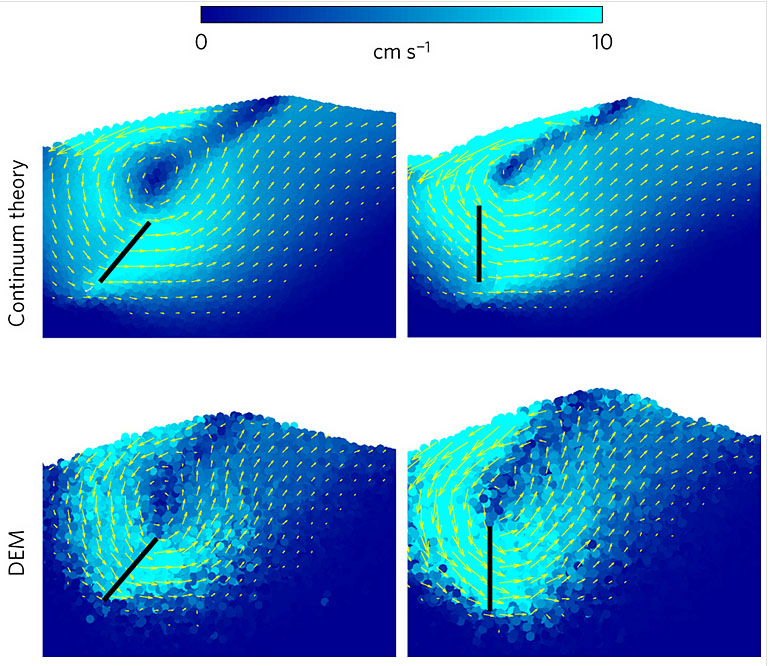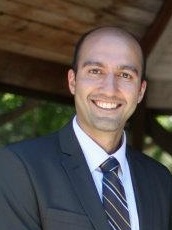Prof. Askari codevelops model that predicts force needed to push objects through sand, other materials

Using only density and a friction coefficient, Hesam Askari, assistant professor of mechanical engineering, and his mentor, Ken Kamrin, are able to simulate the mechanics of an object moving through granular materials, as shown in the top figures, with the same precision – and in a fraction of the computational time – compared to using more complicated discrete element analysis (bottom figures).
For years, engineers have used a set of equations formally known as resistive force theory (RFT) to calculate how much force is required to move an object through fluids or granular material – such as propelling an unmanned rover through the depths of the ocean or pushing a shovel through sand.
But they didn’t know why the theory works so well, particularly with granular materials. Now, Hesam Askari, an assistant professor of mechanical engineering at the University of Rochester, and his mentor at MIT, have provided the answer with a “simple and elegant” theoretical model published in Nature Materials.
Now, Hesam Askari, an assistant professor of mechanical engineering at the University of Rochester, and his mentor at MIT, have provided the answer with a “simple and elegant” theoretical model published in Nature Materials.
The model will enable researchers to quickly calculate the force required to move objects over or through whole classes of previously untested granular materials in a variety of settings. Applications could range from designing vehicles to traverse granular terrains on distant planets, for example, to understanding how lizards “swim” through sand here on earth -- even to targeting the delivery of drugs through particle-filled tissues in the human body.
RFT was first developed in the 1950s to describe how objects move through viscous fluids. In 2008, researchers at Georgia Tech found that the theory with some variations could even more precisely describe the force needed to move objects through granular material, which is a much more difficult medium than fluids to model.
But nobody was sure why the theory worked and the empiricism of the concept continued.
“The theory is observed to be magically precise but strictly empirical, which means you can test it on sand and, sure, it works in sand. You can test it on glass beads and, sure, it works on glass beads,” Askari says. “But if you don’t have a theoretical foundation for it, you cannot say for certain that it will work for other flowable materials as well without running even more tests. What we accomplished puts guesswork aside and shows roots of this beautiful theory -- so no more magic!”
And empirical-based testing of RFT can be extraordinarily time-consuming. Typically, researchers must first create a small square plate made of the same material as the larger object they want to push through a given granular medium. They must then run hundreds of experiments to determine the forces that are exerted on the plate oriented at different angles as it moves in various directions. They must then proportionately multiply and add the findings to “reconstitute” the larger object and the total force exerted on it.
For two years, Askari, then a postdoc, worked with his mentor, Ken Kamrin, associate professor of mechanical engineering at MIT, on solving the mystery of RFT. They identified two main properties of granular materials that allowed them to come up with a simple, predictive model that consistently replicated the empirical findings of previous RFT experiments – without having to actually do all those experiments. The properties are a friction coefficient that determines whether a granular material will flow, and a separation rule to account for the temporary “hole” that forms behind the object as it moves, before the separated granules fill in behind it.
The novelty of the modeling approach is that it can simulate millions of particle as a continuum of matter. This will greatly simplify complicated modeling of discrete particles to a continuum simulation, with researchers working a few hours at their laptops, instead of having to wait two days for 24 Blue Hive processors to do the calculations.
The application of the model on the mechanics of intrusion will enable researchers to be much less dependent on experimentation in calculating resistive force in new materials they haven’t worked with before, Askari said.
“What we are telling researchers who study intrusion in granular materials now is, ‘Give us the friction coefficient and density, and we can skip the experiments and construct resistive force plots’” Askari says.
Askari also hopes the model will enable novel teaching and research opportunities across multiple disciplines at Rochester and at other universities.
“When studies are this much easier, it will allow the exploration of so many more materials and applications. For instance, we are currently working with researchers in the Department of Physics and Astronomy on an application to a vibrational swimmer. I really see this as an exciting opportunity for our department and others at the University, such as physics and biomedical engineering, to be more involved in this kind of research,” Askari says. “It is a community that I would love to see formed with a research narrative revolving around mechanics and rheology (flow) of particulate systems.”
“I also see interest in this amongst our undergraduates,” he adds. “They do not often encounter granular materials in their coursework, so it is new for them and interesting.
